Boho colors can give you a sense of freedom, creativity and cultural richness. Use boho color palettes to create relaxed eclectic environments in your home boho decor.
I love colors myself. But I can also appreciate a more neutral palette. Get to know the place, what will it be used for? And how do you want the room to make you feel? Do you like contrasts or a more monochrome interior? There is a time and place for everything. But, never fear… Pour on color if that’s what you’re into 🙂

Boho colors are often featuring earthy tones, deep jewel tones and vibrant accents, these distinctive boho color palettes are often used in interior design to create tranquil environments. Get ready to embrace the bohemian lifestyle.
Combining these colors effectively is an art. Mix patterns, textures and nature-inspired elements to achieve balance and harmony, and get some boho color magic into your life 🙂
Choose boho colors and shades based on the boho style you want to achieve. Whether it’s the refreshing Coastal decor style, to traditional Gypsy style vibes, sweet Boho Chic, cozy Rustic charm or minimalist Scandinavian elegance? You can even explore the adventurous Eclectic Witch, moody Dark Academia, or sleek Japandi!
Boho Colors – Color Psycologi and Symbolism in Boho Decor
Boho colors have a deep symbolism – each shade has both a cultural and emotional meaning. From the spiritual qualities of deep purples to the grounding energy of brown. These shades evoke different feelings and stories.
Understanding the psychology and cultural significance of boho colors will allow you to gain a deeper appreciation of their role in art, fashion and design.

In this article, we will explore the psychology and symbolism of popular boho colors. We’ll also look at how to use these colors effectively in your home boho decor. You’ll learn why boho color schemes are special, what they symbolize, and how to blend them harmoniously.
The bohemian style draws on a rich history of global influences, from Moroccan blues to Indian reds, and Mexican turqouise. It can be interesting to respect the cultural roots of these vibrant colors while blending them into your modern environments.
Moroccan Boho Colors
Moroccan boho colors are characterized by warm earth tones and rich, bold accents that reflect the country’s stunning landscapes and architecture. Shades of terracotta, sand, and deep browns form a neutral base, while vibrant colors like cobalt blue, burnt orange, and lush greens bring energy and life.

These hues are often seen in intricate tile work and textiles, creating a layered, textured look. The use of metallics, such as gold and brass, adds a touch of glamour. This palette embodies a sense of exotic charm and warmth, inviting a feeling of comfort and adventure into any space.
Indian Boho Colors
Indian boho colors are a tapestry of deep jewel tones and earthy shades, creating a sense of warmth and richness. Vibrant saffron, royal blue, and emerald green evoke the country’s vibrant festivals and traditional attire. Earthy browns and rust tones complement these brighter colors, reflecting India’s diverse landscapes and rich textile heritage.
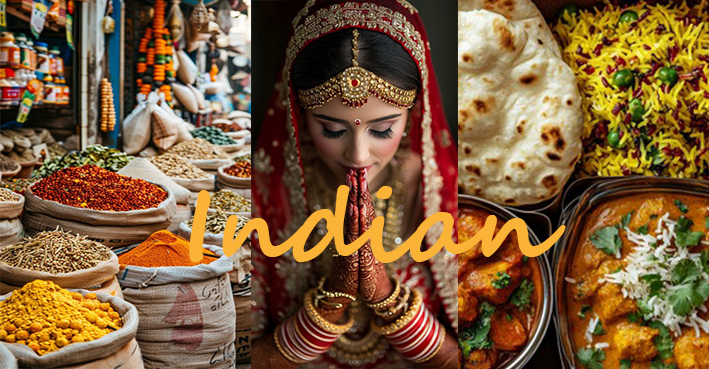
Intricate patterns and prints, often featuring paisleys and mandalas, enhance the boho aesthetic. The use of natural dyes adds depth and authenticity, making each piece unique. This colorful palette captures the spirit of India, blending spirituality with a love for artistry, creating a beautiful and eclectic vibe.
Mexican Boho Colors
Mexican boho colors are vibrant and lively, reflecting the country’s rich cultural heritage. Bright hues like deep reds, sunny yellows, and turquoise blues are commonly used, often inspired by traditional textiles and folk art. These colors evoke a sense of joy and celebration, representing the spirit of community and festivity.
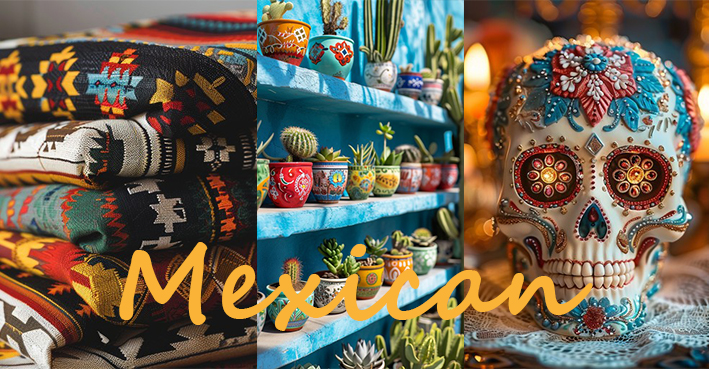
Earthy tones such as terracotta and olive green balance the palette, grounding the vivid shades in nature. Patterns often feature floral motifs, geometric designs, and intricate embroidery, bringing a playful yet warm atmosphere to spaces and fashion, embodying the essence of Mexican culture and its artistic traditions.
Understanding and Choosing Boho Colors in Decor
Boho decor isn’t tied to strict rules. It celebrates mixing styles, patterns, and, of course, colors. Often inspired by nature, the palette includes earthy tones, deep jewel shades, and vibrant accents. Each hue has a unique meaning, evoking specific feelings and emotions.
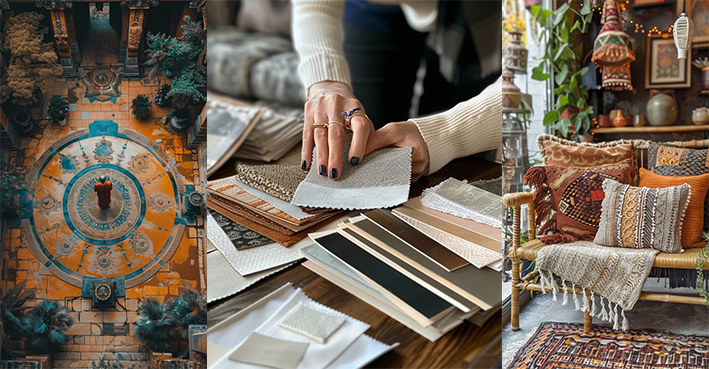
Choosing the right Boho Colors in Decore for your space starts with understanding color psychology. This knowledge will help you create environments that are calm, inspiring, or even energizing. Before you start, make an aesthetic moodboard to make sure the colors you use will go well together.
Let’s look into the most popular boho colors and their psychological effects.
Earthy Tones: Warmth and Comfort
Earthy tones are a staple of boho color palettes. Think of shades like terracotta, burnt orange, deep browns, and warm beige. These colors are reminiscent of nature—soil, sand, and clay. Earthy tones create a grounding effect, making spaces feel welcoming, relaxing and comfortable.
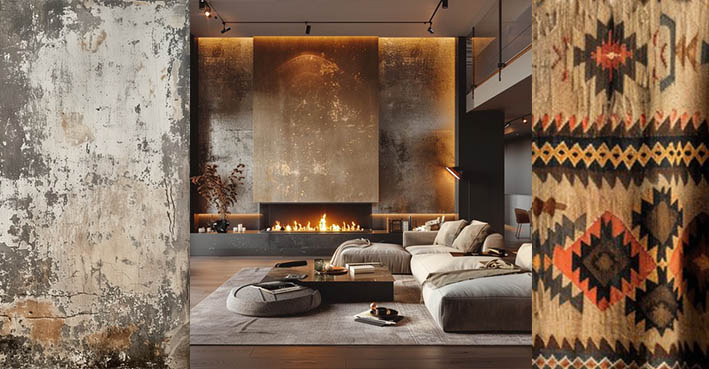
Psychological impact: Earthy tones evoke warmth and stability. They are perfect for creating a calm, nurturing environment. They encourage relaxation and provide a sense of security.
Symbolism: Brown symbolizes strength, stability, and reliability. Terracotta and burnt orange represent creativity and passion. These colors are associated with autumn, the harvest season, and coziness.
Best uses: Use earthy tones in living rooms, reading nooks, and kitchens. They blend well with natural materials like wood, leather, and stone.
Jewel Tones: Depth and Elegance
Jewel tones add richness and depth to boho spaces. Popular choices include emerald green, sapphire blue, ruby red, and amethyst purple. These colors bring a sense of sophistication to any room.

Psychological impact: Jewel tones stimulate creativity and imagination. They create a sense of mystery and luxury. Using jewel tones can make a space feel intimate and inspiring.
Symbolism: Emerald green symbolizes balance, renewal, and growth. Sapphire blue evokes wisdom and tranquility. Ruby red is associated with love, passion, and strength. Amethyst purple stands for spirituality, creativity, and intuition.
Best uses: Jewel tones are perfect for bedrooms and creative spaces. Pair them with metallic accents like gold or brass to enhance their elegance.
Vibrant Accents: Energy and Joy
Bright, vibrant colors are an exciting part of boho color schemes. Shades like mustard yellow, turquoise, fuchsia pink, and bold red are common. These colors add a playful, energetic touch to any space.
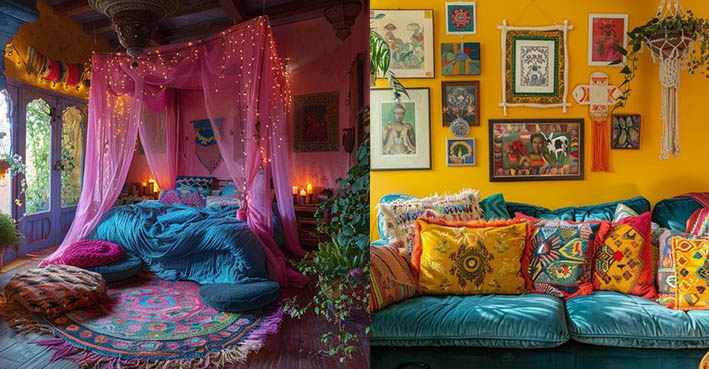
Psychological impact: Vibrant colors boost energy levels and lift the mood. They inspire feelings of joy, enthusiasm, and optimism. Using these hues as accents prevents the room from feeling overwhelming.
Symbolism: Yellow symbolizes happiness and creativity. Turquoise stands for calmness and communication. Fuchsia is linked to playfulness and femininity. Red, depending on its intensity, can symbolize love or excitement.
Best uses: Use vibrant accents sparingly in decor. Think pillows, rugs, and wall art. They work well in rooms that need a splash of energy, like dining rooms or offices.
Neutral Colors: Simplicity and Balance
Neutral colors like white, cream, and soft gray are essential in boho decor. They serve as a backdrop, allowing other colors and patterns to stand out.

Psychological impact: Neutrals create a sense of simplicity and calmness. They balance out stronger colors, making the space feel harmonious.
Symbolism: White symbolizes purity and peace. Cream represents warmth and softness. Gray stands for sophistication and balance.
Best uses: Use neutral colors for walls, large furniture pieces, or as a base in patterned textiles. They make rooms feel serene, spacious and airy.
Nature-Inspired Shades: Connection to the Outdoors
Nature-inspired shades like olive green, forest green, and sky blue are popular in boho decor. These colors bring the outdoors inside, creating a refreshing and calming atmosphere.

Psychological impact: Nature-inspired shades reduce stress and promote relaxation. They connect people to the natural world, making a space feel refreshing and alive.
Symbolism: Green symbolizes growth, harmony, and health. Sky blue represents freedom and serenity. These colors are linked to renewal and peacefulness. Perfect if you want to chill out.
Best uses: Use green and blue tones in bedrooms, bathrooms, or any space where you want a calm, natural feel. Combine them with indoor plants to enhance the effect.
Cultural Symbolism of Boho Colors
Boho decor draws from alot of global influences. Many of the boho colors used in boho style have cultural and spiritual meanings. Respecting these roots adds depth to your decor.
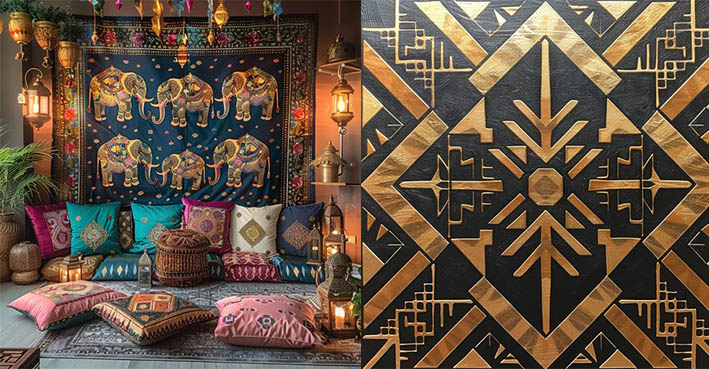
Moroccan Blues: Deep blues and indigos are prominent in Moroccan decor. These boho colors represent protection and spirituality. They’re used in tiles, textiles, and pottery.
Mexican Pinks and Yellows: Bright pinks and yellows are common in Mexican decor. They stand for joy, passion, and life. These shades are often found in folk art, textiles, and painted ceramics.
Scandinavian Whites and Grays: In Scandinavian minimalism, white and gray are the primary colors. They symbolize simplicity, calmness, and functionality.
Indian Reds and Oranges: Rich reds and oranges are popular in Indian design. They symbolize energy, love, and celebration. These boho colors are often seen in vibrant fabrics and traditional art.
Using boho colors with cultural significance can add authenticity to your boho decor.
Creating Boho Color Palettes for Different Styles
Boho decor is versatile, allowing you to mix and match styles. Here are some popular boho styles and their ideal color palettes:
Boho Chic: Focus on soft pinks, creamy whites, and gold accents. This style is feminine and elegant, perfect for living rooms or bedrooms.
Rustic Boho: Use earthy tones like terracotta, deep browns, and forest greens. Add natural textures like wood, rattan, and woven fabrics.
Coastal Boho: Choose ocean blues, sandy beiges, and seafoam greens. This palette creates a fresh, airy feel, perfect for beach houses or bathrooms.
Gypsy Boho: Go for bold, vibrant colors like red, purple, and mustard yellow. Layer with intricate patterns and luxurious fabrics.
Minimalist Boho: Stick to neutral colors like white, gray, and soft browns. Focus on clean lines, simple patterns, and natural textures.
Dark Academia Boho: Use deep jewel tones like emerald, burgundy, and navy. Combine with dark wood furniture and vintage accents for a moody, sophisticated look.
Mixing Patterns and Textures with Boho Colors
Combining different patterns and textures is key to achieving a true boho look. Start with a base of earthy tones or neutrals. Add layers of vibrant colors through textiles and accessories.

Patterns: Use tribal prints, paisley, floral, and geometric patterns. Mix them freely, but stick to a consistent color scheme to avoid clashing.
Textures: Pair smooth fabrics like silk or velvet with rougher materials like jute, rattan, and wool. Textured accents make the room feel more dynamic.
Natural Elements: Incorporate wood, leather, and stone elements to ground the design. These materials blend seamlessly with boho colors and patterns.
The goal is to create a space that feels eclectic but balanced. Each element should have its own place in the overall design.
Color Psychology in Boho Decor
Color psychology is the study of how colors influence mood and behavior. Understanding this can help you choose boho colors that match the atmosphere you want to create.
- Warm colors (red, orange, yellow): These stimulate energy and enthusiasm. They’re ideal for active spaces like kitchens or social areas.
- Cool colors (blue, green, purple): These promote relaxation and calmness. Use them in bedrooms or meditation spaces.
- Neutrals (white, gray, brown): Neutrals create balance and simplicity. They work well in any space as a backdrop.
The Meaning of all other Boho Colors
Boho colors are chosen for their ability to shape the atmosphere of a room. The colors you use can impact mood, perception, and the overall vibe of your space. Let’s explore the psychology and meaning behind each color that commonly appears in boho color palettes.
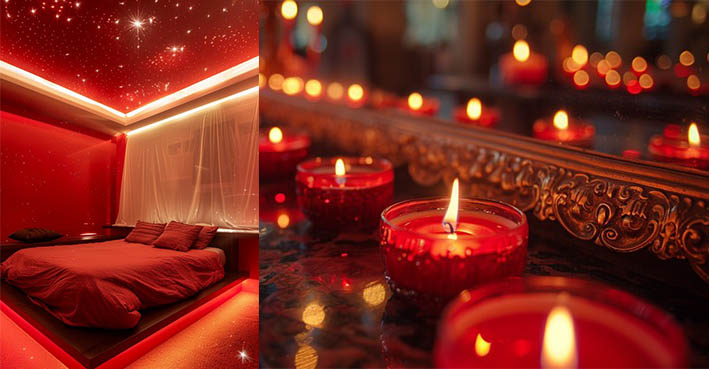
Red in Boho Colors Reflect Strong Emotions
Red is a powerful, energetic color often used in boho decor to make bold statements. It’s associated with passion, excitement, and strength.
- Psychology: Red stimulates energy and enthusiasm. It can evoke feelings of passion and intensity.
- Symbolism: In many cultures, red represents love, power, and courage. It’s a color of celebration and vitality.
- Best Use: Use red as an accent color in rugs, pillows, or art. It works well in social areas like living rooms or dining spaces where you want to encourage lively conversation.
2. Orange in Boho Colors brings in Warmth and Comfy
Orange is a warm, inviting color that adds a playful touch to boho spaces. It’s often seen in earthy shades like terracotta and burnt orange.
- Psychology: Orange is uplifting and cheerful, creating a sense of warmth and happiness.
- Symbolism: Orange is linked to creativity, joy, and spontaneity. It symbolizes enthusiasm and positive energy.
- Best Use: Incorporate orange in cozy areas like reading nooks, kitchens, or as an accent in outdoor spaces. Pair it with natural materials like wood and woven textures.
3. Yellow is the most Joyful of Boho Colors
Yellow is one of the brightest boho colors, symbolizing joy and light. It ranges from soft mustard hues to bold, sunshine yellow.
- Psychology: Yellow evokes optimism and cheerfulness. It enhances focus and creativity.
- Symbolism: Yellow represents happiness, hope, and enlightenment. It’s associated with sunshine and warmth.
- Best Use: Use yellow in home offices, kitchens, or any space where you want to boost energy and creativity. Add it through patterned textiles, cushions, or small decor pieces.
4. Green Boho Colors Brings in Nature
Green is a versatile color often found in nature-inspired boho palettes. It connects interiors to the outdoors, promoting balance and harmony.
- Psychology: Green has a calming and restorative effect, reducing stress and creating a sense of tranquility.
- Symbolism: Green represents growth, renewal, and harmony. It’s linked to nature and health.
- Best Use: Use green in bedrooms, bathrooms, or living spaces where you want a relaxing, natural feel. Complement it with indoor plants to enhance its refreshing effect.
5. Blue for a Clam Boho Colors Ambience
Blue is a cool, serene color that adds depth and calmness to boho decor. It ranges from light sky blue to deep, rich indigo.
- Psychology: Blue evokes peace and tranquility. It helps create a sense of order and encourages introspection.
- Symbolism: Blue represents trust, wisdom, and spirituality. It’s often associated with the sea and sky.
- Best Use: Use blue in areas for relaxation, like bedrooms or reading nooks. Combine it with soft fabrics like linen or silk for a soothing atmosphere.
6. Purple Ads Drama & Mystique to Boho Colors
Purple is one of the most mystical boho colors, often linked to creativity and spirituality. It’s used to add depth and drama to a space.
- Psychology: Purple stimulates imagination and creativity. It can create a sense of luxury and elegance.
- Symbolism: Purple is associated with royalty, magic, and spiritual wisdom. It symbolizes intuition and insight.
- Best Use: Use purple in meditation spaces, creative studios, or as an accent in living rooms. Pair it with gold or metallic elements for a rich, sophisticated look.
7. Pink Romantic Boho Colors
Pink in boho decor can range from soft blush tones to vibrant magenta. It adds a touch of sweetness and playfulness.
- Psychology: Pink evokes feelings of compassion, love, and kindness. It can create a soothing and uplifting environment.
- Symbolism: Pink represents affection, femininity, and nurturing. It’s often associated with comfort and romance.
- Best Use: Use pink in bedrooms, nurseries, or as an accent in boho chic spaces. It pairs beautifully with cream, gold, and other soft colors.
8. Brown Boho Colors Give You a Natural Feel
Brown is a grounding, earthy color that forms the foundation of many boho color palettes. It connects the decor to the natural world.
- Psychology: Brown evokes warmth, stability, and reliability. It makes a space feel cozy and secure.
- Symbolism: Brown symbolizes resilience, strength, and dependability. It’s linked to the earth and natural materials.
- Best Use: Use brown in living rooms, dining areas, or anywhere you want to create a comfortable, welcoming atmosphere. Combine it with wood furniture, leather accents, and woven textures.
9. White Purity make Boho Colors stand out
White is a versatile color that adds brightness and simplicity to boho interiors. It serves as a blank canvas for layering patterns and vibrant hues.
- Psychology: White creates a sense of peace and clarity. It makes spaces feel open, clean, and airy.
- Symbolism: White represents purity, innocence, and new beginnings. It’s linked to simplicity and minimalism.
- Best Use: Use white as a base color on walls or large furniture pieces. It balances out bold patterns and vibrant accents in a boho room.
10. Gray for a Modern Boho Feel
Gray is a neutral, sophisticated color that adds a modern touch to boho decor. It ranges from light dove gray to deep charcoal.
- Psychology: Gray promotes a sense of calmness and balance. It can make spaces feel elegant and timeless.
- Symbolism: Gray symbolizes neutrality, wisdom, and composure. It’s often used to create a sophisticated and serene environment.
- Best Use: Use gray in bedrooms, living rooms, or as a grounding element in patterned textiles. Pair it with brighter accents to create a balanced boho look.
11. Black for Contrast
Black is a dramatic, powerful color that adds depth and contrast to boho spaces. It’s used sparingly to create a bold, sophisticated effect.
- Psychology: Black evokes mystery, elegance, and strength. It can create a sense of luxury when used in moderation.
- Symbolism: Black symbolizes power, sophistication, and formality. It can also represent protection and authority.
- Best Use: Use black as an accent in frames, lighting fixtures, or textiles. Combine it with metallics or jewel tones for a dramatic boho vibe.
12. Gold in Boho Colors
Gold is a luxurious, warm color that adds a touch of glamour to boho decor. It’s often used to highlight and enhance other boho colors.
- Psychology: Gold evokes warmth, positivity, and opulence. It creates a sense of richness and abundance.
- Symbolism: Gold symbolizes wealth, success, and wisdom. It’s linked to achievement and celebration.
- Best Use: Use gold in small doses—think mirrors, lamps, or decorative accents. Pair it with deep jewel tones like emerald or amethyst for a rich, boho-inspired look.
13. Turquoise Apply Freshness in Boho Colors
Turquoise is a bright, refreshing color that adds a sense of tranquility to boho spaces. It’s a popular choice in boho color palettes.
- Psychology: Turquoise promotes calmness and emotional balance. It can make spaces feel serene and welcoming.
- Symbolism: Turquoise represents communication, healing, and clarity. It’s linked to water and the sky.
- Best Use: Use turquoise in bathrooms, kitchens, or as an accent in textiles and accessories. It pairs well with warm tones like terracotta or mustard yellow.
By understanding the psychology of these boho colors, you can create spaces that resonate emotionally and visually. Choose colors that reflect your mood and style to design a unique, inspiring boho interior.
Practical Tips for Using Boho Colors in Your Home
Here are some easy tips to incorporate boho colors into your decor:
- Start with a neutral base: Choose neutral colors for large pieces like walls or sofas.
- Add layers of color: Use pillows, rugs, and curtains to introduce vibrant hues.
- Mix patterns carefully: Stick to a consistent color scheme to tie patterns together.
- Use nature-inspired shades: Choose colors that reflect the natural world for a serene feel.
- Incorporate metallic accents: Gold, copper, and brass add warmth and sophistication.
Conclusion
Boho colors are a powerful tool for expressing your creativity and personal style. Each shade carries its own unique psychology and symbolism, bringing layers of meaning to your decor. You can try a refined monochrome palette or go wild and embrace the freedom to mix and match vibrant eclectic boho colors as you wish.
Some people prefer a steady, grounded boho decor aesthetic, while others transform their space into a playful, ever-changing canvas that shifts in sync with their moods. Hope that you will have fun creating your own boho colors unique playground.

